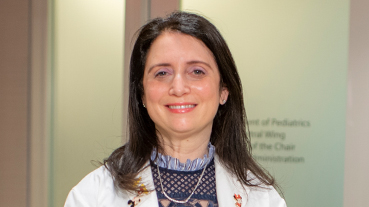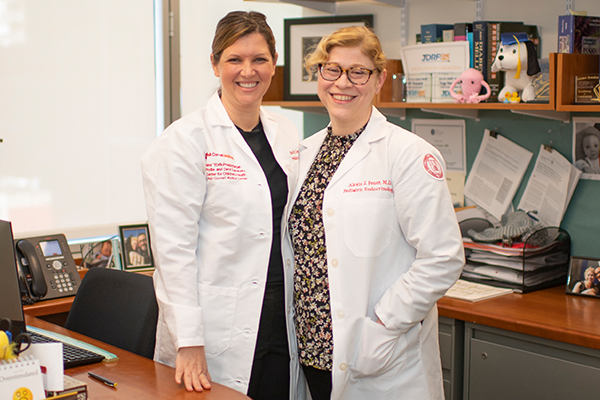Moving On: Transitioning from Pediatric to Adult Diabetes Management
Pediatric and adult endocrinologists at NewYork-Presbyterian/Weill Cornell Medical Center are collaborating on a new transition clinic to ease the passage for pediatric patients with type 1 diabetes to adult care, a program vitally important both for maintaining continuity and quality of care as well as reducing complications.
Developed by Alexis Jamie Feuer, MD, Co-Director of the Pediatric Diabetes Program; Emily Coppedge, CPNP, CDE, Pediatric Nurse Practitioner and Diabetes Educator; and Tiffany Yeh, MD, an endocrinologist in the Department of Endocrinology, Diabetes, and Metabolism, the transition program includes having the first official adult visit take place in the pediatric practice to provide a familiar and comfortable environment for the patient and their family.
Emily Coppedge, CPNP, CDE, and Alexis Jamie Feuer, MD
“We've had a wonderful opportunity to watch our patients grow up through the years,” says Dr. Feuer. “That’s part of the joy of working in pediatrics – you see your very young patients become school-age, adolescents, teenagers, and then young adults. We’ve also been fortunate in that our patients tend to come in regularly for visits. They have the expectation that if they have problems in managing their diabetes, we are here to help them. There is a lot of attachment and trust between our patients and our pediatric providers. So, we want to be sure to guide them to the next level of care. Even though they’ve lived with diabetes for a long time, when it suddenly becomes their own personal responsibility to take care of the disease, it can be overwhelming to a young person.”
Tiffany Yeh, MD
“Transitioning from pediatric to adult care has always been challenging, no matter what the medical specialty,” says Dr. Yeh. “However, unlike some specialties that require less day-to-day monitoring and tailoring, for type 1 diabetes there is a lot of miniscule management that occurs. And children with type 1 diabetes tend to have a difficult time transitioning, primarily because of their multiple medical issues, as well as psychosocial factors. Our goal was to establish a streamlined, formal transition process so that our young patients can switch over to adult care seamlessly. We term that a ‘warm handoff.”
“When you are diagnosed with diabetes, even if you’re a late teen, it’s a pivotal moment in your life,” says Ms. Coppedge. “The patients’ attachment to the team happens because we’re with them during a life-changing event for them and their family. Whether we have treated them for only a year, or we've known them for 15 or 20 years, changing providers is a huge step for patients and families. But the transition is a sign of the patient now taking full control over their diabetes.”
In an ideal world, says Dr. Feuer, they would be preparing adolescents for transition years ahead of the time that they would have to move to a new provider. “Right now, we introduce the idea when they're approximately 18 years old, maybe a little earlier depending on their maturity level,” she says. “If we know that their plans include going out of town for college, we start to discuss the fact that we are a pediatric clinic, and that we are going to have to find them a new medical home in the internal medicine world. We do get a little pushback because our kids don’t always like to leave. Some are excited at the idea, but more are generally not thrilled. So that’s why we break it in slowly over the course of several visits.”
Dr. Feuer and Ms. Coppedge share a particular affinity for children with type 1 diabetes as both of them also live with this disease. “This will be my 30th year with type 1 diabetes,” says Dr. Feuer. “I can remember when I went off to college, I didn’t think I had an issue with transitioning. And here I was at NYU as an 18-year-old and all of a sudden, I had to figure out how do I get my blood sugar test strips? Do I have to pay for them? Do I get reimbursed? It was an entirely new world that I was not at all prepared for. I don't want any of my patients to feel that way, unprepared for not only being a young adult and having all those challenges, but also to have this huge burden of a chronic disease that requires real daily management. That’s why this program is very important to us.”
Prior to the pandemic, the team planned to arrange the first meeting with Dr. Yeh in person. “That changed quickly, and we moved to telemedicine, which actually has worked out well,” says Dr. Yeh. “We’ve been able to meet and greet quite a few patients, rather than trying to get them into the clinic physically.”
“Getting patients to come in can be difficult, but they love the video visits,” agrees Ms. Coppedge. “Beforehand I would have to sit with a patient to help them make the call to set up the appointment. It helps so much to arrange that video visit with Dr. Yeh first. She is so friendly and wonderful with them and that first conversation breaks down that discomfort barrier for them.”
During that visit, Ms. Coppedge reviews the patient’s care history and treatment plan with Dr. Yeh. ”After the call, patients are much more reassured and often say, ‘she’s nice…I’m ok…I feel good to go.’ Whereas previously when we’ve asked people to transition, they would never make that appointment.”
“We have already transitioned several young adults into adult care, and we are reaching out to more young patients to transition over,” says Dr. Yeh. “This program is not just an idea anymore; we're implementing it and getting young adults connected into adult care.”
It’s never too early to begin education in diabetes management and, in March, the team is hosting a program for middle school children. “Parents know what diabetes means, but when you talk to a child of 12 who was diagnosed at the age of 2, you get a blank look,” says Ms. Coppedge. “They’ve lived with it, they’ve been told they have it, and they kind of know what it is, but they don’t really understand it. With this program we will go through some developmental tasks that they should be starting to work on, such as making sure they know where to give injections and the basics of carb counting on their own. Then we’ll be doing more developmentally appropriate education for the high school age group.”
Related Publications









